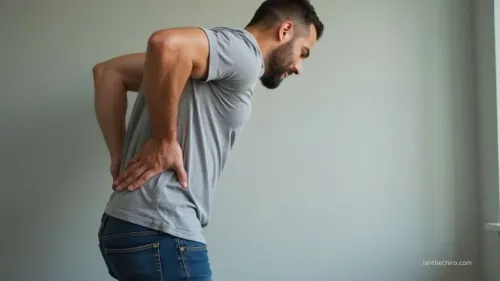Beyond Calcium: How Spinal Movement Builds Bone Density According to Wolff's Law
Spinal movement does more than provide flexibility; it builds bone density as per Wolff's Law.
When you incorporate dynamic spinal motions like flexion, extension, and rotation, you apply mechanical stress that spurs bone remodeling, enhancing bone mass. Osteocytes, the bone's sensors, respond to these stresses, promoting growth and balance between osteoblasts and osteoclasts. This process is crucial in osteoporosis prevention.
Discover how targeted exercises further support spinal health and overall well-being.
Understanding Wolff’s Law and Its Impact on Bone Health

Understanding Wolff’s Law offers valuable insights into optimizing bone health through strategic movement and exercise. According to this principle, bones strengthen in response to the mechanical stresses placed upon them.
Wolff’s Law reveals how strategic movement enhances bone strength through mechanical stress.
When you engage in activities that involve spinal movements like flexion and rotation, you trigger a response that enhances bone density. The key is hitting the minimum effective strain, typically between 1500–2500 microstrain, to stimulate osteocytes.
These cells convert mechanical signals into biochemical actions, promoting bone formation. Regular movement is essential as chronic disuse leads to bone loss.
Therefore, incorporating spinal exercises supports stronger bones and overall health.
The Role of Spinal Movement in Bone Remodeling
When you engage in spinal movement, you're not just enhancing flexibility but actively participating in bone remodeling. Spinal movements generate mechanical loads on your vertebrae, essential for stimulating new bone growth.
According to Wolff's Law, bones adapt to these stresses, with strain levels between 400 to 1500 μɛ promoting bone formation. This dynamic activity helps maintain bone homeostasis by balancing osteoblast and osteoclast activity, ensuring bone resorption doesn't surpass formation.
Studies show that movement-based therapies focusing on spinal flexibility and strength boost bone density, especially in those at risk for osteoporosis, by harnessing mechanotransduction processes involving osteocytes.
Flexion, Extension, and Rotation: Key Spinal Movements for Bone Density

As you integrate flexion, extension, and rotation into your routine, you're effectively engaging the spine in ways that boost bone density.
These movements apply mechanical loading on the vertebrae, stimulating bone remodeling as per Wolff's Law. Flexion and extension exercises promote axial loading, essential for osteoblast activity and bone formation.
Rotational movements dynamically engage spinal muscles, enhancing bone mineral density through increased mechanical strain.
By regularly incorporating these movements, you encourage your spine to adapt, increasing bone mass and strength.
This proactive approach not only supports spinal health but also helps prevent osteoporosis as you age.
The Science Behind Mechanical Stress and Bone Growth
Although many factors contribute to bone health, mechanical stress stands out as a fundamental driver of bone growth and remodeling. Your spine’s movements, like flexion, extension, and rotation applies dynamic loading, which enhances bone adaptation more effectively than static loading.
Wolff's Law explains that bone density increases at areas under the greatest strain, with the minimum effective strain ranging from 1500–2500 μɛ. Osteocytes, the bone's mechanosensory cells, sense these mechanical forces and convert them into signals that encourage bone formation.
However, avoid excessive strain, as levels over 10,000 μɛ risk fractures. Properly applied stress supports your bone's health and integrity.
Incorporating Dynamic Spinal Exercises Into Your Routine
To effectively boost your bone density and spinal health, incorporating dynamic spinal exercises into your routine is essential.
By engaging in twisting, flexion, and axial loading movements, like squats and deadlifts, you stimulate bone adaptation in line with Wolff's Law. These exercises generate mechanical loading and internal strain levels between 400 to 1500 microstrain (μɛ), which promote bone mass and density.
Engage in twisting and axial movements like squats to boost bone density and strength.
Regularly practicing these movements builds muscle strength around the spine, maintaining bone health and reducing fracture risks.
Combine these dynamic exercises with weight-bearing activities to optimize bone density and counteract the effects of disuse or aging.
Benefits of Improved Spinal Health and Posture
When you prioritize spinal health and posture, you're not just standing taller; you're considerably enhancing your bone density. Proper alignment distributes stress evenly across vertebrae, promoting better bone density as per Wolff's Law.
Ideal posture engages muscles effectively, increasing the mechanical load on the spine and stimulating bone growth. Maintaining a strong, flexible spine reduces vertebral fracture risks, especially in older adults.
Frequently Asked Questions About Spinal Movement and Bone Density
What Is the Wolff's Law of the Spine?
Wolff's Law explains that spinal bones adapt to mechanical stress. Regular spinal movement, such as flexion and rotation, stimulates bone remodeling, increasing density and strength. Prioritizing dynamic exercises helps maintain spinal health and posture.
What Is Wolff's Law of Bone Density?
Wolff's Law states that bones strengthen in response to mechanical stress. Engaging in physical activities encourages bones to increase in density. Exercises involving spinal movement are effective in supporting bone health and preventing loss.
How Do Bones Grow in Width According to Wolff's Law?
Bones grow in width through a process called appositional growth, which is influenced by mechanical stress. Spinal movements stimulate this process, promoting increased bone width and structural strength.
What Is the Role of Exercise in Calcium Absorption and Building Bone Density?
Exercise supports calcium absorption and stimulates bone-building activity. Weight-bearing and resistance exercises activate bone cells, improving mineral density. Combining regular movement with proper nutrition enhances overall bone strength.
Conclusion: Why Spinal Movement Matters for Bone Strength
Incorporating spinal movement into your daily routine supports both flexibility and bone density.
According to Wolff’s Law, movements like flexion, extension, and rotation apply mechanical stress that encourages bone remodeling. Relying solely on calcium is not enough, dynamic spinal exercises are a practical method to support posture and strengthen spinal structures.
Consistency in applying these movements helps maintain bone health and reduce long-term degeneration risks.














